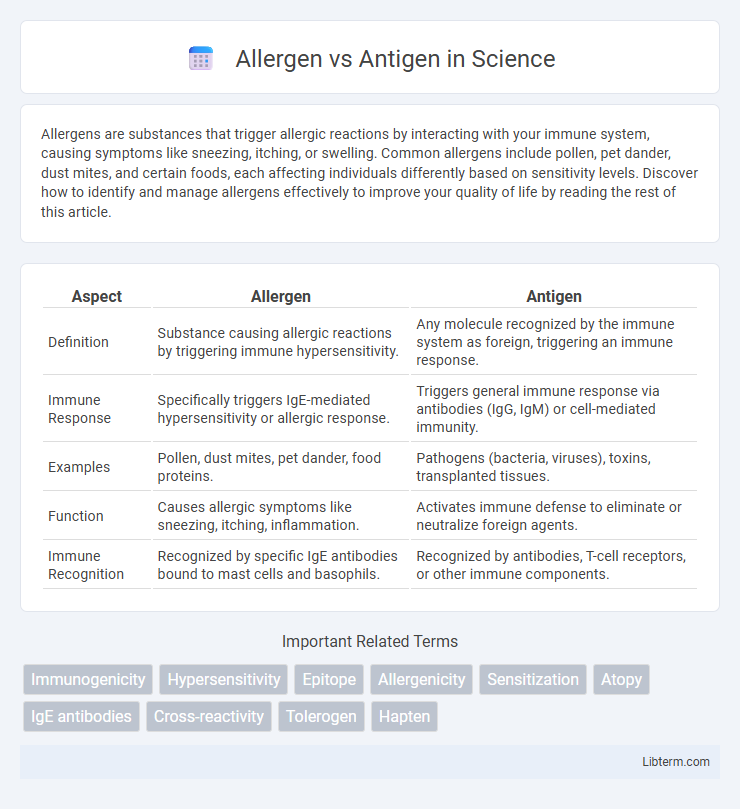Allergens are substances that trigger allergic reactions by interacting with your immune system, causing symptoms like sneezing, itching, or swelling. Common allergens include pollen, pet dander, dust mites, and certain foods, each affecting individuals differently based on sensitivity levels. Discover how to identify and manage allergens effectively to improve your quality of life by reading the rest of this article.
Table of Comparison
| Aspect | Allergen | Antigen |
|---|---|---|
| Definition | Substance causing allergic reactions by triggering immune hypersensitivity. | Any molecule recognized by the immune system as foreign, triggering an immune response. |
| Immune Response | Specifically triggers IgE-mediated hypersensitivity or allergic response. | Triggers general immune response via antibodies (IgG, IgM) or cell-mediated immunity. |
| Examples | Pollen, dust mites, pet dander, food proteins. | Pathogens (bacteria, viruses), toxins, transplanted tissues. |
| Function | Causes allergic symptoms like sneezing, itching, inflammation. | Activates immune defense to eliminate or neutralize foreign agents. |
| Immune Recognition | Recognized by specific IgE antibodies bound to mast cells and basophils. | Recognized by antibodies, T-cell receptors, or other immune components. |
Introduction to Allergens and Antigens
Allergens are typically harmless substances such as pollen, dust mites, or pet dander that trigger immune system hypersensitivity reactions in susceptible individuals. Antigens are molecules or molecular structures, often proteins, found on the surface of pathogens like bacteria, viruses, or foreign cells, which elicit an immune response. Both allergens and antigens interact with the immune system but differ in origin and their role in immune activation.
Defining Allergens: What Are They?
Allergens are specific types of antigens that trigger an immune response resulting in allergic reactions, distinct from general antigens that may provoke broader immune defenses. These substances, such as pollen, pet dander, or certain foods, are typically harmless to most people but cause hypersensitivity in susceptible individuals. Understanding the molecular structure and immune pathways involved in allergens is crucial for diagnosing and treating allergic conditions effectively.
Understanding Antigens: Core Concepts
Antigens are molecules, often proteins, that trigger immune responses by being recognized as foreign by the body's immune system. All antigens have the potential to bind specifically to antibodies or T-cell receptors, initiating a complex immune defense mechanism. Understanding the molecular structure and function of antigens is crucial for advancements in immunology, vaccine development, and allergy research.
Key Differences Between Allergens and Antigens
Allergens are specific types of antigens that trigger allergic reactions by stimulating an exaggerated immune response, while antigens broadly encompass any substance that the immune system recognizes as foreign, including pathogens like bacteria or viruses. Unlike antigens, allergens primarily cause hypersensitivity and involve immunoglobulin E (IgE) mediated mechanisms. Understanding this distinction is essential for diagnosing allergies and developing targeted immunotherapies.
How the Immune System Responds
The immune system responds to antigens by recognizing them as foreign substances and activating a broad immune response involving T cells and B cells to neutralize or destroy the invader. Allergens, a specific type of antigen, trigger an exaggerated immune response characterized by the production of IgE antibodies, leading to histamine release and allergic symptoms such as inflammation, itching, and swelling. This hypersensitive reaction distinguishes allergen responses from typical antigen responses, which aim primarily to protect against pathogens without causing such adverse effects.
Common Examples of Allergens and Antigens
Allergens commonly include pollen, dust mites, pet dander, mold spores, and certain foods such as peanuts and shellfish, which trigger allergic reactions by stimulating immune responses in sensitive individuals. Antigens, on the other hand, encompass a broader range of substances including pathogens like bacteria, viruses, and fungi, as well as foreign proteins and toxins that prompt the immune system to produce antibodies. While allergens specifically cause hypersensitivity responses, antigens represent any molecule that the immune system identifies as foreign and potentially harmful.
Allergen-Induced Allergies and Reactions
Allergens are specific types of antigens that trigger allergic reactions by stimulating an exaggerated immune response in sensitive individuals. Common allergen-induced allergies include pollen, pet dander, food proteins, and insect venom, which activate IgE antibodies leading to symptoms like sneezing, itching, and anaphylaxis. Understanding the distinction between allergens and general antigens is crucial for diagnosing and treating allergic conditions effectively.
Role of Antigens in Immunity and Vaccination
Antigens are foreign substances that trigger immune responses by being recognized by antibodies or immune cells, playing a crucial role in identifying pathogens. Unlike allergens, which provoke hypersensitive reactions in susceptible individuals, antigens are essential for the development of immunity by stimulating the production of specific antibodies and memory cells. Vaccines exploit antigens to safely expose the immune system to a pathogen, enabling the body to mount a protective response without causing disease.
Diagnosing Allergen and Antigen Responses
Diagnostic testing for allergens typically involves skin prick tests or specific IgE blood tests that identify hypersensitive immune responses to harmless substances. In contrast, antigen detection relies on assays such as ELISA or rapid antigen tests to identify foreign pathogens or substances triggering an immune reaction. Accurate differentiation between allergen-induced IgE-mediated responses and antigen-specific immune activity is essential for appropriate clinical management and targeted treatment strategies.
Preventing and Managing Allergen Exposure
Preventing and managing allergen exposure involves identifying common allergens such as pollen, dust mites, pet dander, and mold, and minimizing contact through regular cleaning, air filtration systems, and allergen-proof bedding. Using hypoallergenic products and maintaining indoor humidity between 30-50% can reduce allergen presence and improve respiratory health. Immunotherapy and antihistamines are effective medical strategies that help control allergic reactions triggered by antigens in sensitized individuals.
Allergen Infographic

 libterm.com
libterm.com